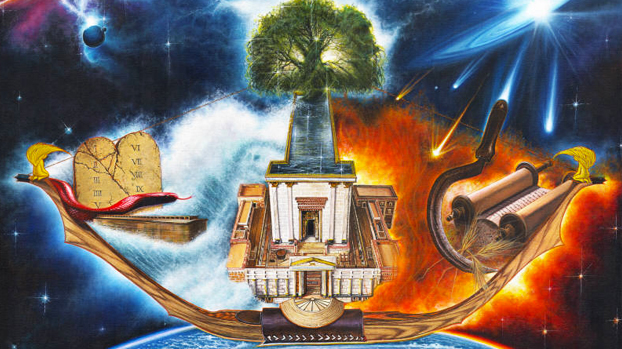
In an essay on Parshat Ki Tetse (the weekly Torah portion) by Lord Chief Rabbi Jonathan Sacks, he speaks about the evolution of an ideal society. After leaving Egypt – a huge accomplishment unto itself – the Israelites had a number of wars to fight, but it was important not to see those wars as the only end. The true end goal of the Israelites was not to win wars or capture land, but to build a new society, to create a new dream. Yet the reality of the civilization is acknowledged – the Torah addresses what happens when soldiers want to take captive women for their own pleasure, or when parents and children mistreat one another, for “Ki Tetse does not address a society of saints. It is a programme for the real world with all its failings and conflicts.” (79)
The Torah has a very subtle approach to ethics because it understands that Judaism exists within the span of human time, for “the Israelites were commanded to create an ideal society. But this is the work, not of a day, but of many centuries.” (80) Judaism takes a long time to uproot the cultural practices that preceded it, such as slavery, the pursuit of war and the mistreatment of women. Small steps are taken over the course of history in order to make things better as we go. Perfection cannot be expected right away, but we continue to teach our children Torah principles, even if we no longer keep unwilling women or nail the ears of slaves to the doorpost. We learn Torah for its message of constantly seeking, constantly building an ideal society. “That way, they will continue the journey and take it further. Judaism is about the long slow walk from the real to the ideal.” (81) And slowly, “the reasons that causes human beings to acquire others as slaves lose their legitimacy. Only then can slavery be abolished.” (82)
In this way, the continued conversation about revelation, the meaning of law, the value of text, and yes, Foucault, the conversation surrounding Jewish sexual ethics works to propel us down the path from the real to the ideal. Jewrotica.org functions to do just that, making room for all voices and perspectives in the continued efforts for the creation of an ideal society and an ideal Jewish approach to sex and sexuality.
42 – Goldwurm, Hersh, and Nosson Scherman, Talmud Bavli = [Talmud Bavli] : The Schottenstein Edition : The Gemara : The Classic Vilna Edition, with an Annotated, Interpretive Elucidation, as an Aid to Talmud Study (Brooklyn, NY: Mesorah Publications, 1990) Tractate Berakhot, 62a
43 – Smokler, Daniel, “Can There Be a Popular, Morally Compelling, Rabbinic Judaism in North America?” Social Action Exchange: Reflecting on American Judaism, The Bronfman Center for Jewish Student Life (New York, NY: 4 Mar 2013) Lecture.
44 – Willis, Ellen, “Next Year in Jerusalem,” Ellen Willis (N.p., n.d Web Mar 2013) .
45 – Proverbs 3:18
46 – Babylonian Talmud, Tractate Bava Metzia, 59b
47 – Babylonian Talmud, Tractate Eruvin, 13b
48 – Sconce, Jeffrey, Haunted Media: Electronic Presence from Telegraphy to Television (Durham, NC: Duke UP, 2000), 4-6.
49 – Sconce (Haunted Media), 7.
50 – Winkler (Sacred Secrets) 3.
51 – Winkler (Sacred Secrets) 4-6
52 – Teplitsky, Joshua. “”For This Is Torah, and I Must Learn:” Sexuality and Textuality in Talmud.” Mini Course: People of the Book, People of the Body. The Bronfman Center for Jewish Student Life, New York, NY. 19 Sept. 2011. Lecture.
53 – Teplitsky (For This is Torah).
54 – Winkler (Sacred Secrets) 4-6.
55 – Foucault (History of Sexuality) 60-61
56 – “Jewrotica Fantasies – Lilith,” Jewrotica. Ed. Limor Blockman (N.p., 21 Dec 2012: Web Jan 2013) .
57 – Nicholas, Stephen A. “Confession #16 – Southeastern United States: My Rabbi,” Jewrotica (N.p., 11 Feb 2013: Web Feb. 2013) .
58 – Babylonian Talmud, Tractate Sotah 17a
59 – Maimonides, Moses, and Eliyahu Touger, Mishneh Torah: A New Translation with Commentaries and Notes (Yerushalayim: Moznayim, 1988) Hilchot Issurei Bi’ah 21:9.
60 – Winkler (Sacred Secrets) 38.
61 – Winkler (Sacred Secrets) 10-11
62 – Luzzatto, Samuel David, Yesode Ha-Torah, (Yerushalayim: Mosad Ha-Rav Ḳuḳ, 1947) Ch. 43.
63 – Winkler (Sacred Secrets) 11-12
64 – Genesis 38:15-16
65 – Genesis 30:15-16
66 – Ruth 3:7.
67 – Winkler (Sacred Secrets) 11-17.
68 – Winkler (Sacred Secrets) 15-16.
69 – The First Abstinence Website for Jewish Teens, Orthodox Union, (n.d. Web Mar 2013) .
70 – Lampert, Simi, “Yeshiva U. Students Can Talk Sex,” The Jewish Daily Forward (N.p., 17 Dec 2011: Web Jan 2013) .
71 – Lampert (Yeshiva U).
72 – Smokler (Can There Be a Popular, Morally Compelling, Rabbinic Judaism in North America?).
73 – Smokler (Can There Be a Popular, Morally Compelling, Rabbinic Judaism in North America?).
74 – Sokol, Moshe Z, “Personal Autonomy and Religious Authority,” Rabbinic Authority and Personal Autonomy, Ed. Moshe Z. Sokol (Northvale, NJ: J. Aronson, 1992).
75 – Ross (Expanding the Palace of Torah) 197.
76 – Ross (Expanding the Palace of Torah) 198.
77 – Ross (Expanding the Palace of Torah) 198.
78 – Smokler (Can There Be a Popular, Morally Compelling, Rabbinic Judaism in North America?).
79 – Sacks, Jonathan, “Ki Tetse: Animal Welfare,” Covenant and Conversation (13 Sept 2008) 1.
80 – Sacks (Ki Tetse) 4
81 – Sacks (Ki Tetse) 1
82 – Sacks (Ki Tetse) 4
You may also like...
3 Comments
-

[button link="https://jewrotica.org/tag/pg/" color="#ff0066" size="3" style="1" dark="0" radius="auto" target="self"]PG[/button] [button link="https://jewrotica.org/tag/pg-13/" color="#ff0066" size="3" style="1" dark="0" radius="auto" target="self"]PG-13[/button] [button link="https://jewrotica.org/tag/rated-r/" color="#ff0066" size="3" style="1" dark="0" radius="auto" target="self"]R[/button] [button link="https://jewrotica.org/tag/xxx/" color="#ff0066" size="3" style="1" dark="0" radius="auto" target="self"]XXX[/button]




Like Us!
-
-
 jewrotica | February 18, 2023
jewrotica | February 18, 2023
Celebrating 10 Years & Marking the End of An Amazing Project
-
 jewrotica | November 23, 2016
jewrotica | November 23, 2016
-
 jewrotica | February 14, 2015
jewrotica | February 14, 2015
-
 sarah | February 28, 2013
sarah | February 28, 2013
-
 Karalyn | February 27, 2013
Karalyn | February 27, 2013
-
 Hugo Schwyzer | November 13, 2012
Hugo Schwyzer | November 13, 2012
-
 jewrotica | February 18, 2023
jewrotica | February 18, 2023
Celebrating 10 Years & Marking the End of An Amazing Project
-
 jewrotica | November 23, 2016
jewrotica | November 23, 2016
-
 jewrotica | February 14, 2015
jewrotica | February 14, 2015
-
 Arturo Desimone | May 2, 2019
Arturo Desimone | May 2, 2019
-
 Joseph Dunsay | May 1, 2019
Joseph Dunsay | May 1, 2019
-
Testimonials
At Jewrotica’s Evening of Bedside Readings, students declaimed monologues on sexual encounters that had a Jewish twist. At Columbia/Barnard Hillel, the speakers pushed their own boundaries by performing a range of explicit narratives that challenged how the audience thought of the relationship to Judaism and sex. During the speakers’ preparation, the arguments about which narratives would be appropriate forced students to take a stand and voice their opinion on their own beliefs about Judaism an… Read more
Engagement Coordinator at Columbia University / Barnard HillelThe Jewrotica event “Evening of Jewrotica: Bedside Reading” was awesome. As Master of Confessions, I got to read the deepest, darkest secrets of people in the room out loud… It was scintillating, titillating, and – yes – even educational!
Sam S., Young Professional in the Austin AreaI’m into Jewrotica. I went in for my second circumcision.
Josh Karp, Artist and Staff at JewliciousI love the inclusiveness – there is something for everyone, in and out of the Jewish community.
Delma Catalina, Student Leader at Texas State UniversityJewrotica rocks. It’s funny, it’s informative, it’s sexy, it’s interesting. Check it out!
Sam C., Young Professional in the Valley, CAWhat an incredible night Jewrotica was!!!! There was this fantastic moment, in a sea of Jews of all sexualities, ages, backgrounds and denominations, that I realized we were all in this together! I hope that there are many more events coming to Austin soon!
Brandon Poland, Award-Winning Jewish Drag QueenJewrotica is awesome. It expands the mind and for people who were raised with narrow views on sexuality. Whether you are Jewish or not, or in different sects of Judaism like Orthodox, Conservative or Reform, no matter what your background or where you’re from, Jewrotica gets you to see Judaism and how it relates to sexuality in new ways. I really appreciate Ayo being here and helping us learn different ways to connect with our sexuality.
Vanessa Steiner, Young Professional in Southern CaliforniaYou may not tell your mom that you’re going to a live Jewrotica reading (or whatever clever name you will dub these events) but you will tell your friends. However, both would be jealous if they find out that they missed it. I think it will only be a matter of time before Jewrotica helps us reclaim the term “Dirty Jew” the way rap music has done for “The ‘N’ Word.” I know I am now proud to be a Dirty Jew!
Ozzy Zion Nelson, Former Hillel JCSC Fellow and Quizmaster at Geeks Who DrinkJewrotica was everything I had dreamed of and more: sexy attendees, tantalizing confessions, and well-written literature to boot! More importantly, it empowers us Jews to reach inside and own our sexy selves and heritage!
Erin L., University of Texas at Austin Social Work Graduate StudentJewrotica is something that the community has needed for a long time so that people can actually learn, express and share and have good relationships without having to stumble through life. Check out the site and learn something. Have fun!
Josh Kaplan, Jewish Community Organizer in Orange County, CADear Jewrotica
Confess
Copyright © 2014 Jewrotica.org. All Rights Reserved.
Built with Love and Mischief.
Designed by Ayo Oppenheimer and
David Abitbol





Pingback: Encounter and Havdalah | Jewrotica
Pingback: This is Torah, and I Must Learn – Jewrotica
Pingback: Encounter and Havdalah – Jewrotica